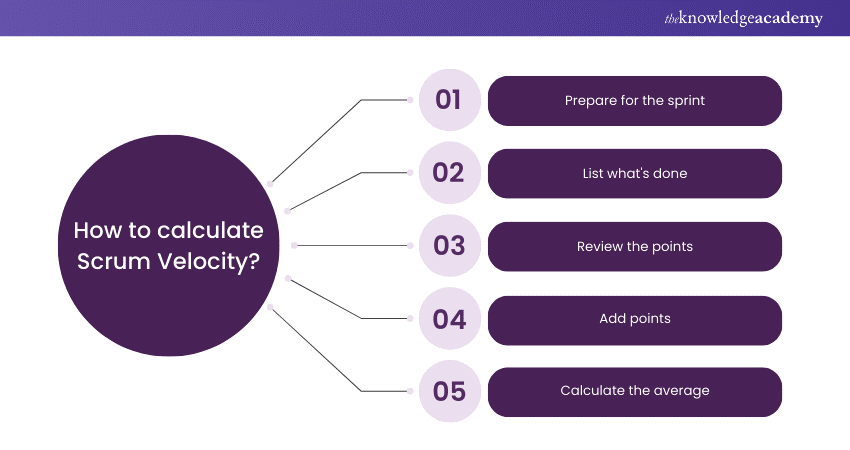We may not have the course you’re looking for. If you enquire or give us a call on +48 221041849 and speak to our training experts, we may still be able to help with your training requirements.
We ensure quality, budget-alignment, and timely delivery by our expert instructors.

Scrum Velocity is like a guide in Project Management that helps teams complete their work efficiently. Imagine it as the pace at which a team gets things done during a project phase called a “sprint.” It’s a simple way to see how much work they can handle and how quickly they can move forward. This pace isn’t just about speed; it tells the story of the team’s work, the hurdles they overcome, and their victories in managing the project smartly and effectively. It shows a team’s hard work turning into real results.
Table of Contents
1. Understanding What is Scrum Velocity
2. How to calculate Scrum Velocity?
3. Factors affecting Velocity in Scrum
4. Avoid these when calculating Velocity in Scrum
5. Conclusion
Understanding What is Scrum Velocity
Velocity in Scrum is an important measure that shows how much work a team can complete in one sprint. Think of it as a helpful number that helps plan the work. During the planning stage, the team looks at their past velocity to decide how many tasks they can realistically finish in the upcoming sprint. This helps them set a realistic goal and a timeline. After the sprint ends, they’ll see the real velocity, which they’ll use to plan better for the next sprint.
Velocity can be measured in story points, like a scale for judging the size of work based on how tricky or risky it is. Instead of counting hours, story points give a better picture of the effort needed.
Take making a login screen for an app, for instance. If it seems fairly straightforward, it might get 3 story points. However, adding a complicated payment system might be rated 8 story points because it’s tougher and has more things that could go wrong.
The story points a person can handle in a two-week sprint can vary. It depends on their know-how, the task’s difficulty, and how well the team works together. Usually, new teams can do about 5–10 story points per person in each sprint.
Knowing the team’s velocity is great for improving over time. It helps in planning ahead, setting sensible goals, and keeping a steady pace. This way, teams can guess how long projects will take and keep everyone involved up to date.
How to calculate Scrum Velocity?
To determine the Scrum Velocity, you add the story points for all the tasks the team finished in a sprint. Here’s a simpler way to understand the steps:

a) Prepare for the sprint: Before starting, give each task several points based on how big or complex it is. For example, simple tasks might be 5 points, while more complex ones could be 8 or even 21 points. The team decides which tasks they can do in the next sprint, considering their usual pace and special circumstances like holidays.
b) List what’s done: At the end of the sprint, note down all the tasks finished and approved by the team leaders.
c) Review the points: Make sure each finished task has the right points. If something needs to be changed, now’s the time.
d) Add points: To find the sprint’s velocity, simply add the points for all the finished tasks. For instance, if three tasks were done with points 5, 8, and 3, the total velocity is 16 points.
e) Calculate the average: To get a steady pace for planning, average the velocities from several sprints. If the last three sprints had velocities of 14, 16, and 15, the average would be ( frac{14 + 16 + 15}{3} = 15 ) points.
Gain a deep understanding of the Scrum teams with our Scrum Product Owner Course - join today!
Factors affecting Velocity in Scrum
Several elements can affect a team’s Scrum Velocity, which is crucial for planning and improving performance:
a) Team size and expertise: The number of team members and their skill levels can change how much work gets done in a sprint. More people might mean more work done, but it can also bring communication and coordination issues. A smaller team with high skills might do better by handling complex tasks more efficiently.
b) Team consistency and history: Teams that have worked together on several sprints tend to work better. They know each other’s strengths and have good communication. This experience can lead to a better velocity.
c) Task complexity: The velocity might be lower if the sprint has many difficult tasks. The story points must reflect the real complexity of the tasks. Some teams mix easy and hard tasks to keep a steady velocity.
d) Outside factors: Depending on another team for certain updates, company events, and public holidays can affect velocity. Good planning and communication can help reduce these impacts.
Enhance your organisational efficiency through our Scrum For Teams Course - join today!
Using Velocity in Scrum
Understanding your team’s velocity in Scrum is crucial for effective sprint planning and Project Management. Let’s take a look:
a) Estimating upcoming sprints: Utilising the average velocity—say, 50 story points from the last three sprints—provides a solid foundation for future sprint planning. A backlog with a similar story point count for the next sprint signifies a well-grounded commitment.
b) Project timeline projections: Stakeholders prefer estimates based on solid data over speculative figures. With a project backlog totalling 200 story points and an average team velocity of 50 story points per sprint, it’s reasonable to predict the project will be completed in approximately four sprints.
c) Spotting commitment issues: Significant deviations in velocity, such as a drop to 30 or a surge to 70 story points, signal potential problems. A decrease may indicate an overburdened team, while an increase suggests they might not be sufficiently challenged. Recognising these signs enables timely interventions, like task redistribution or sprint goal adjustments.
d) Monitoring progress and efficiency: Observing velocity trends over time is insightful for gauging team efficiency and identifying persistent challenges. An increase in velocity from 40 to 60 across sprints suggests that process enhancements are taking effect.
Boost your Agile projects skills with our Managing Agile Projects With Scrum Course - join today!
Avoid these when calculating Velocity in Scrum
When calculating Scrum Velocity, avoiding certain pitfalls is essential to maintain its integrity. Here are the key points to consider:
a) Exclude incomplete work: Do not factor in story points from user stories or bug fixes that have yet to be fully completed. Only completed work should contribute to the velocity calculation.
b) Focus on team metrics: Velocity should be measured at the team level, not individually. It reflects the team’s collective effort and productivity, not the individual members.
c) Avoid tying Velocity to rewards: Linking velocity to bonuses or rewards can lead to ‘story point inflation’—a tendency to underestimate story points to meet or exceed velocity targets, skews the metric’s accuracy.
Conclusion
Scrum Velocity transcends mere numerical value; it encapsulates a team’s synchronised efforts and ability to achieve milestones. It mirrors the collective cadence and the proficiency with which a team navigates through sprints. This metric is a testament to a team’s agility, resilience, and commitment to continuous improvement. The rhythm propels teams forward, harmonising their skills to orchestrate a symphony of successful deliveries.
To be an expert at Scrum, sign up for our Scrum Master Certification today!
Frequently Asked Questions
What is a good Scrum Velocity?

A good Scrum Velocity reflects consistent team performance and improves over time, indicating a mature and efficient Agile process.
Can Scrum Velocity vary between teams?

Yes, Scrum Velocity can vary between teams due to differences in team size, composition, experience, and the nature of the project.
What are the other resources and offers provided by The Knowledge Academy?

The Knowledge Academy takes global learning to new heights, offering over 30,000 online courses across 490+ locations in 220 countries. This expansive reach ensures accessibility and convenience for learners worldwide.
Alongside our diverse Online Course Catalogue, encompassing 17 major categories, we go the extra mile by providing a plethora of free educational Online Resources like News updates, Blogs, videos, webinars, and interview questions. Tailoring learning experiences further, professionals can maximise value with customisable Course Bundles of TKA.
What is the Knowledge Pass, and how does it work?

The Knowledge Academy’s Knowledge Pass, a prepaid voucher, adds another layer of flexibility, allowing course bookings over a 12-month period. Join us on a journey where education knows no bounds.
What are related courses and blogs provided by The Knowledge Academy?

The Knowledge Academy offers various Scrum Certification Training, including Scrum Master Certification Course, Scrum Product Owner Training and Scrum Developer Training. These courses cater to different skill levels, providing comprehensive insights into Agile Project Management With Scrum.
Our Project Management Blogs cover a range of topics related to Scrum, offering valuable resources, best practices, and industry insights. Whether you are a beginner or looking to advance your Project Management skills, The Knowledge Academy's diverse courses and informative blogs have you covered.
Upcoming Project Management Resources Batches & Dates
Date
 Scrum Master Certification
Scrum Master Certification
Thu 13th Mar 2025
Thu 20th Mar 2025
Thu 27th Mar 2025
Thu 3rd Apr 2025
Thu 24th Apr 2025
Thu 1st May 2025
Thu 22nd May 2025
Thu 5th Jun 2025
Thu 19th Jun 2025
Thu 3rd Jul 2025
Thu 17th Jul 2025
Thu 31st Jul 2025
Thu 14th Aug 2025
Thu 11th Sep 2025
Thu 25th Sep 2025
Thu 2nd Oct 2025
Thu 9th Oct 2025
Thu 16th Oct 2025
Thu 23rd Oct 2025
Thu 30th Oct 2025
Thu 6th Nov 2025
Thu 13th Nov 2025
Thu 20th Nov 2025
Thu 27th Nov 2025
Thu 4th Dec 2025
Thu 11th Dec 2025
Thu 18th Dec 2025






 Top Rated Course
Top Rated Course



 If you wish to make any changes to your course, please
If you wish to make any changes to your course, please


